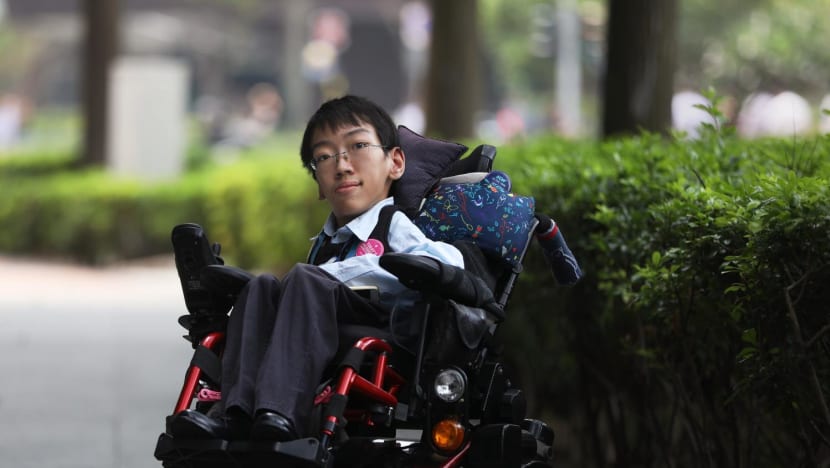Commentary: Life-changing treatments for my terminal disease may soon be within reach, but here’s why I’m going to hold off

At this year’s Committee of Supply debate, Nominated Member of Parliament Ong Hua Han asked the Ministry of Health (MOH) to consider extending financial help for patients with spinal muscular atrophy (SMA) to access disease-modifying treatments. Such treatments improve patients’ quality of life, but are not full-fledged cures.
He cited a crowdfunding campaign by Singaporean games journalist Sherry Toh, who is trying to raise S$375,000 for a one-year supply of the drug Evrysdi (risdiplam), an oral medication to be taken daily. Evrysdi is the only treatment option registered with and approved by our Health Sciences Authority.
Another treatment, Zolgensma, is a one-time gene therapy, but must be administered before a child turns two years old. It costs upwards of S$2 million.
Children in Singapore have access to Zolgensma on a compassionate use basis. A few have managed to benefit from this drug, following successful crowdfunding campaigns to raise the millions of dollars needed.
SMA, which I am also affected by, is a congenital neuromuscular disorder in which the nerve cells that carry messages from the brain to the rest of the body weaken and die, causing progressive muscle weakness.
Most patients are unable to stand or sit unsupported. As the disease worsens, problems with swallowing, speaking, and breathing occur.
SMA is a rare disease — according to a 2023 MOH statement, there are only about 40 to 50 patients in Singapore. It is also terminal.
THE CASE FOR DISEASE-MODIFYING TREATMENTS
I’ve never been one to sugarcoat or romanticise my condition. The fact is: It sucks.
I can’t do many things most people would consider routine, like moving around independently or eating delicious food. Even the simple things that I can do for myself take huge reserves of energy, and I find myself tired and in discomfort all the time.
Because of SMA, I will never experience many wonderful facets of life: A rollercoaster ride; a night out drinking at the bar; having a kid and teaching him to play football.
With the advent of disease-modifying treatments (DMTs), especially when administered to a young child who is still in the early stages of the disease, these things are no longer a pipe dream.
Children in the United States who were given Zolgensma as newborns several years ago are now running around schoolyards with their friends — something that would have been unfathomable a decade ago.
Closer to home, Ms Toh noted on her campaign page that her ability to swallow water improved after she received a complimentary three-month supply of Evrysdi on a compassionate basis from manufacturer Roche.
Before, she would have taken about 52 seconds to drink a given amount of water. After starting on the drug, her time decreased to 16 seconds.
ADDING UP THE COSTS
DMTs have changed the SMA landscape forever. But every discussion on DMTs in Singapore runs into the same issue: Cost.
In the US, insurance covers the cost of DMTs and allows ready access to those who need it.
Here in Singapore, though, patients have no option at the moment but to figure out a way to pay the exorbitant price tag on their own.

Here are my rough calculations: If I want to get treated with Evrysdi, I would have to work my white-collar office job for more than five years to save up enough for a single year of treatment.
This is why I’m ambivalent about even starting on the drug, which relies on taking consistent doses in order to sustain its effects.
What happens if I no longer have access to this costly drug? The joys and freedoms, and the improvements to my quality of life it would bring — all those positive effects would go away in an instant.
It seems really cruel to put myself through that. And so, I’d rather not commit to the treatment while financial cost is still the biggest stumbling block to my continued access to it.
I don’t enjoy having SMA — but after 26 years, I’ve come to terms with it. I’ve become used to living my life while working around the ever-increasing limitations my disease places on me.
I’m in no hurry to plunge myself into a situation where I have to constantly worry about running out of money to buy medicine, or be subject to the trauma of finding myself robbed of my newfound strength and independence all over again.
FACING THE REALITIES
Don’t get me wrong: I’m not saying I don’t want medicine that could better my life.
If our health insurance system suddenly became like the US’s overnight, and I could access Evrysdi with little worry about the price, I would take it in a heartbeat.
But the reality is that our system is set up completely differently. It’s not my intention to “fix” our system with this piece — plenty of other highly qualified writers and experts have suggested solutions to the affordability problems facing rare disease treatment.
For example, the Rare Disease Fund (RDF) could potentially help SMA patients afford DMTs, if SMA gets added to the list of diseases it covers.
But even if so, the RDF has a very small quantity of funds available to it, and a growing quantity of demand on these funds. SMA is just one of a whole constellation of rare diseases out there, and treatments for all of them are just as expensive, if not more so.
It would of course be ideal to help every patient who needs support — but we don’t live in an ideal world. Funds are finite. There are only two options: Be selective in who gets help, or get more funds.
Getting more funds is, in turn, a whole other can of worms because of opportunity cost.
If the government allocates more money to the RDF, that’s money taken away from some other use or need, like education or assisting the elderly or cushioning the impact of inflation on the lower income.
At the governmental level, I trust Singapore is doing the best it can for the RDF.
That brings us back to being selective in who gets help.
Unfortunately, allocating resources is, by nature, a zero-sum game.
Let me put it this way: If the RDF has to choose between subsidising treatment for me or a young child also suffering from SMA, I’d rather medical help goes to the kid.
Stopping his SMA progression at a much earlier stage means he will retain more of his physical abilities and strength.
He will have his whole life ahead of him, giving him a much longer runway to do lots of amazing things that I can only dream of.
A REASONABLE STEP FORWARD
While we figure out how to address the funding gap, one intermediate step I do wish for the authorities to consider is to make SMA testing more prevalent in Singapore.
Many developed nations screen newborns for SMA through a simple blood test. According to Novartis, which developed Zolgensma, 45 per cent of babies in Europe are tested for SMA at birth. This compares to 44 per cent in Australia and an impressive 80 per cent in Taiwan.
Early detection of SMA is crucial in the age of DMTs because the sooner the patient begins treatment, the better the outcome in the long run.
Besides rolling out more widespread newborn screening for SMA, I’d like Singapore to dream even bigger: Introduce routine carrier testing for the gene that causes SMA. This is also possible through a simple blood test.
I understand from my relatives’ experiences with starting a family that, currently, couples are advised to get tested for the gene only if they have a family member with SMA like me.
But with one in 40 people carrying the SMA gene, there are actually many people out there who are blissfully unaware. All it takes is for two of them to procreate, and their child will have a 25 per cent chance of having SMA.
I personally always encourage my newly married friends to ask for the test before having kids.
If couples are aware of their carrier status before they try for a baby, they will be in a better position to make an informed decision on whether to go ahead with reproductive efforts or consider alternatives such as adoption.
NO EASY ANSWERS
Ultimately, SMA is a devastating disease which incurs costs that go far beyond the financial. The physical and psychological toll it takes on patients and their families cannot be quantified.
Making any decisions regarding SMA — or any other rare disease for that matter — is a highly personal affair involving a complex interplay of each individual’s dreams, fears, beliefs, values, and life circumstances.
There are no easy or correct answers, but with the knowledge we have available to us at any given moment, we can make the decision that feels right for us, and then make the best of it.
ABOUT THE AUTHOR:
Jonathan Tiong, 26, works in corporate communications and employee engagement. He has Type 2 spinal muscular atrophy. As an advocate for disability inclusion in corporate employment, Jonathan has shared his views and advice in interviews and panel discussions. He also writes regularly on various topics and platforms.











